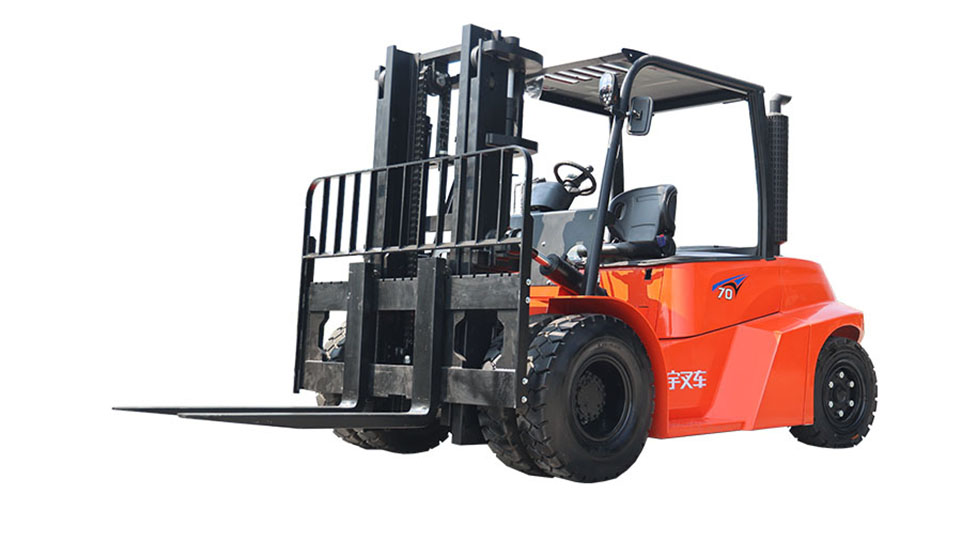
Diesel forklifts are indispensable in warehouses and industrial facilities, but prolonged operation can lead to persistent arm and muscle pain for operators. This discomfort stems from a combination of ergonomic flaws, vibrational forces, and unnatural postures inherent to traditional forklift design. In this article, we explore the root causes of such pain, drawing on biomechanical research, industry case studies, and ergonomic best practices to provide actionable solutions.
1. Ergonomic Design Flaws in allis chalmers diesel forklift
Most diesel forklifts prioritize durability over operator comfort, leading to design elements that strain the musculoskeletal system.
A. Fixed Seating and Poor Adjustability
Many seats lack lumbar support or height-adjustable features, forcing operators into awkward positions.
Fixed armrests may not align with natural sitting postures, placing strain on shoulders and wrists.

B. Non-Ergonomic Controls
Steering wheels and joystick systems often require constant grip force, leading to forearm fatigue.
Foot pedals placed too far apart necessitate unnatural leg extensions.
2. Vibration Exposure from Diesel Engines
Diesel engines generate significant low-frequency vibrations (2–100 Hz), transmitted through the seat and steering column.
Health Impacts:
Hand-Arm Vibration Syndrome (HAVS): Prolonged exposure can cause numbness, tingling, and muscle weakness.
Whole-Body Vibration (WBV): Linked to lower back pain and spinal disc degeneration.
Frequency of Exposure:
Operators in warehouses often endure 8-hour shifts with vibrations exceeding ISO 2631-1 safety thresholds.
3. Repetitive Strain Injuries (RSI)
Continuous use of controls and repetitive motions exacerbate muscle fatigue.
Common RSIs:
Rotator Cuff Tendonitis: From repeated overhead lifting or checking loads.
Carpal Tunnel Syndrome: Caused by tight grips on steering wheels or joysticks.
Case Study:
A 2022 study found that 68% of forklift operators reported wrist pain after shifts involving frequent load transfers.
4. Postural Stress from Confined Workspaces
Operators often sit in cramped cabins with limited visibility, leading to poor posture.
Risks:
Forward Head Posture: Straining cervical muscles to view dashboards or loads.
Static Postures: Prolonged sitting without movement reduces blood flow, accelerating muscle fatigue.
5. Diesel Engine Noise and Mental Fatigue
Constant engine noise (85–95 dB) contributes to stress, indirectly worsening physical discomfort.
Effects:
Elevated cortisol levels increase muscle tension and pain perception.
6. Lack of Anti-Vibration Mitigation
Unlike electric forklifts, diesel models lack advanced vibration-dampening technologies.
Comparative Analysis:
Feature Diesel Forklifts Electric Forklifts
Vibration Levels High (ISO 2631-1 Exceeds) Low (Regulated to <2.5 m/s²)
Seat Suspension Basic Pneumatic/Magnetic Systems

7. Preventive Measures and Solutions
A. Ergonomic Upgrades
Install adjustable seats with lumbar support and sliding armrests.
Retrofit cabins with anti-vibration mounts and ergonomic joysticks.
B. Work Practice Adjustments
Follow the 20-20-20 Rule: Every 20 minutes, adjust posture for 20 seconds.
Use assistive devices (e.g., pallet jacks) for repetitive load transfers.
C. Medical Interventions
Physical therapy to strengthen core and upper body muscles.
Wrist braces or ergonomic gloves to reduce strain.
8. Regulatory Standards and Employer Responsibilities
OSHA Guidelines: Require employers to provide ergonomic assessments and training.
EU Directives: Mandate vibration exposure limits (e.g., 2.5 m/s² daily exposure).
9. Future Innovations in Forklift Design
Active Suspension Systems: Reduce vibrations by up to 40%.
AI-Assisted Posture Monitoring: Alerts operators to unnatural movements.
Conclusion
Arm and muscle pain from driving diesel forklifts arises from a toxic blend of poor ergonomics, vibration exposure, and repetitive motions. Addressing these issues requires a multi-faceted approach: upgrading equipment with anti-vibration technologies, enforcing ergonomic best practices, and prioritizing operator health through regular training. As the industry shifts toward electrification, future forklifts may eliminate many of these pain points—but until then, proactive measures are essential to safeguarding worker well-being.
Name: selena
Mobile:+86-13176910558
Tel:+86-0535-2090977
Whatsapp:8613181602336
Email:vip@mingyuforklift.com
Add:Xiaqiu Town, Laizhou, Yantai City, Shandong Province, China